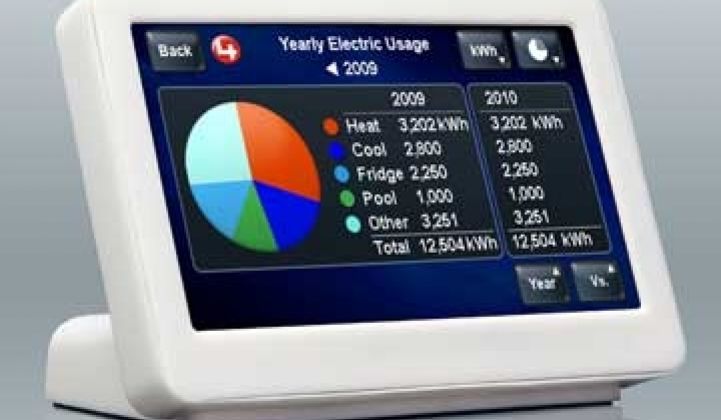Control4 unveiled new software today to accompany its Energy Management System 100 (EMS 100). The flash-based open platform software, called ADVANTAGE, is designed so that utilities and developers can build applications to integrate with the EMS 100.
Control4, which also builds other wireless home networking systems from audio systems to temperature control, is confident that their system will not only blend in with a utility’s back end to optimize demand response, but also engage the customer.
“We’re coming from the consumer side,” said Susan K. Cashen, vice president of marketing for Control4 Energy. “Most of the focus on the feedback has been on the in-home experience.”
The company is hoping the 5-inch screen display, which will allow customers to monitor everything from a wireless thermostat and other smart devices, could also host applications such as Facebook, RSS feeds and Netflix, to make it a one-stop destination for not just energy management, but also for apps that fit every facet of a consumer’s life. Move over iBeer. Get ready for an app where your wireless thermostat and refrigerator can tweet for you.
On the utility side, Control4 is touting the analytics that will allow power providers not only gather data on individual houses, but also build models of how an entire neighborhood behaves that will allow them to build more accurate demand response.
The Salt Lake City-based company also announced partnerships that they are confident will bring their hardware and software to a larger segment of the market. Control4 is teaming up with Lockheed Martin to connect their EMS 100 and ADVANTAGE software with the defense company’s SEEload demand response platform.
“We’re providing the connection from the EMS100 directly back to SEEload with whoever [Lockheed Martin] partners with,” said Richard Walker, president of Control4 Energy Systems. “We’ve always been hardware and software agnostic, which has helped us on the partnership front.”
Lcokheed Martin, along with other defense contractors, is eager to bring their security expertise to smart grid (see Defense Contractors Pursue the Smart Grid). But Lockheed isn’t stopping at just security; it also wants to provide full demand response with its SEEgrid platform, which includes demand response, microgrid management and grid security for utilities.
Lockheed is already working with PPL Electric Utilities, Rappahannock Electric Cooperative, American Electric Power Co. and Northern Virginia Electric Cooperative on designing security solutions (see Lockheed Expands Its Smart Grid Wings).
Control4 is banking that their system can overcome some of the backlash in smart grid rollouts (see Oncor Reacts to Smart Grid Anger) by drumming up consumer confidence while pursuing partnerships that will hopefully get its product into homes. After all, what good is a secure, dynamic smart grid if the consumer rejects it?
Software & Analytics

Control4 Announces New Software, Partners With Lockheed Martin
Control4 releases new open-source software it says is geared towards the user experience, as well as the utility’s back end.

Control4 Announces New Software, Partners With Lockheed Martin
-
41Where Will DOE’s Loan Program Make the Next Climate Tech Investments?
-
15What the Frack Is Happening With Natural Gas Prices?
-
9With an Energy Crisis Brewing, No Peak in Sight for Emissions


